
Crusader coin types: Overstrikes put them in chronological order.
Some overstrikes are easy to decipher and some are not. The second coin below is overstruck and the sequence is easy to see. Another example (further below) is not so easy to determine.
What's new? May 31, 2025: An overtruck coin of Roger of Salerno at Antioch.
Why? Why would a ruler have his own coins overstruck? It was a way used in medieval times to collect taxes called "Renovatio Monetae". Under this system coins don't circulate permanently. The government occasionally announces that the current types will soon be demonetized. Then coins must be replaced by taking them in and having them (over)struck with the new type. However the state returns fewer of the new type and the rest is its profit (a type of tax). Use of the old types becomes illegal with draconian penalties. Schindel thinks this happened yearly and dates the types using this assumption.
Most crusader coins are poorly struck--many badly off-center--which sometimes allows parts of the undertype to not be obliterated and still be recognizable outside the area struck by the overtype. The first and second coins are of the same type, but the second has an undertype which can be identified.

21 mm. 3.00 grams.
A type of Tancred. CCS Antioch 5.
Bust of Christ
Cross with letters for "Tancred" in the quadrants
TA NK
P H
and floral ornament at the base of the cross.

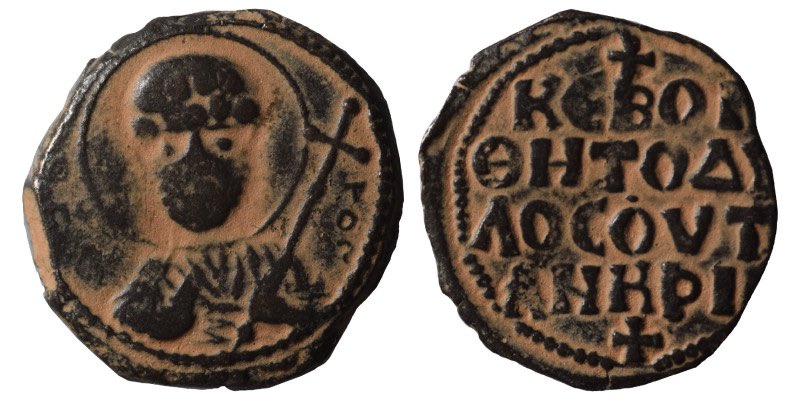
Tancred's first type, the undertype of the above coin. The flan for that coin was a coin of this type struck off-center such that this reverse was shifted upward so the first line was partially off the edge of the flan.
Overstruck, but which strike is on top? This crusader coin of Tancred is overstruck. Which strike is first and which is over it?
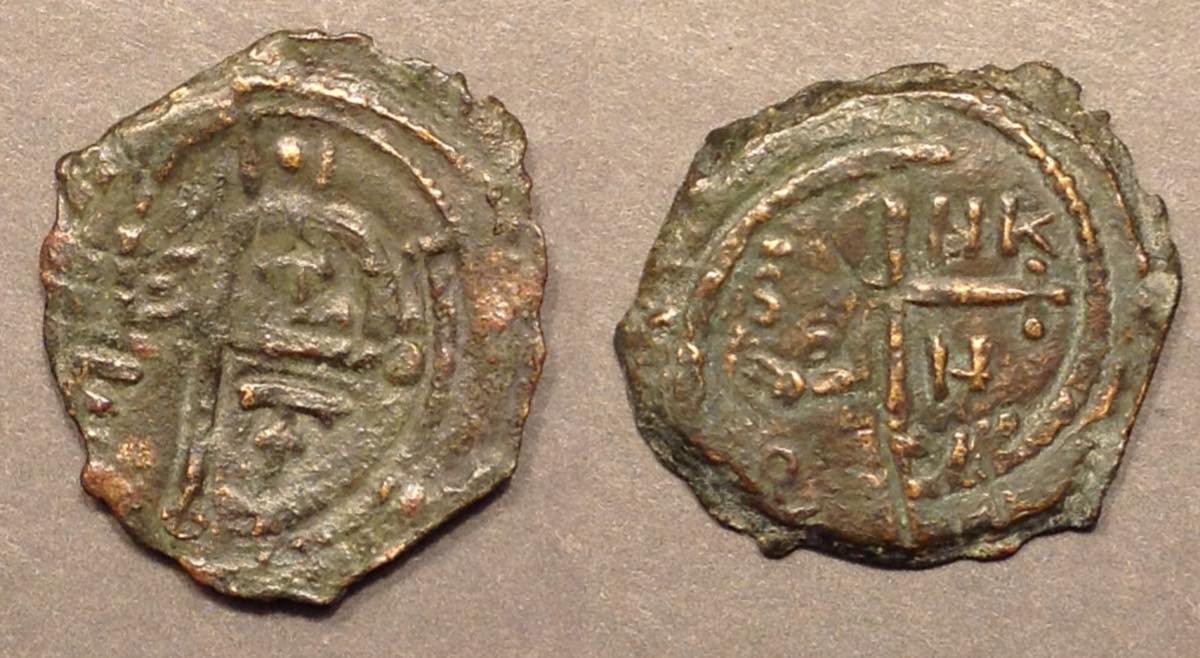
23-20 mm. 4.11 grams.
Image 1
First let's identify the two types involved.
Here is one type in the right orientation. Perhaps the reverse is the easiest to match up.

21 mm. 3.00 grams.
CCS Antoch 5. Tancred.
Bust of Christ
Cross with letters for "Tancred" in the quadrants and floral ornament at the base of the cross.
Next is the other type involved, followed by a different image of the overstruck coin oriented that same way.

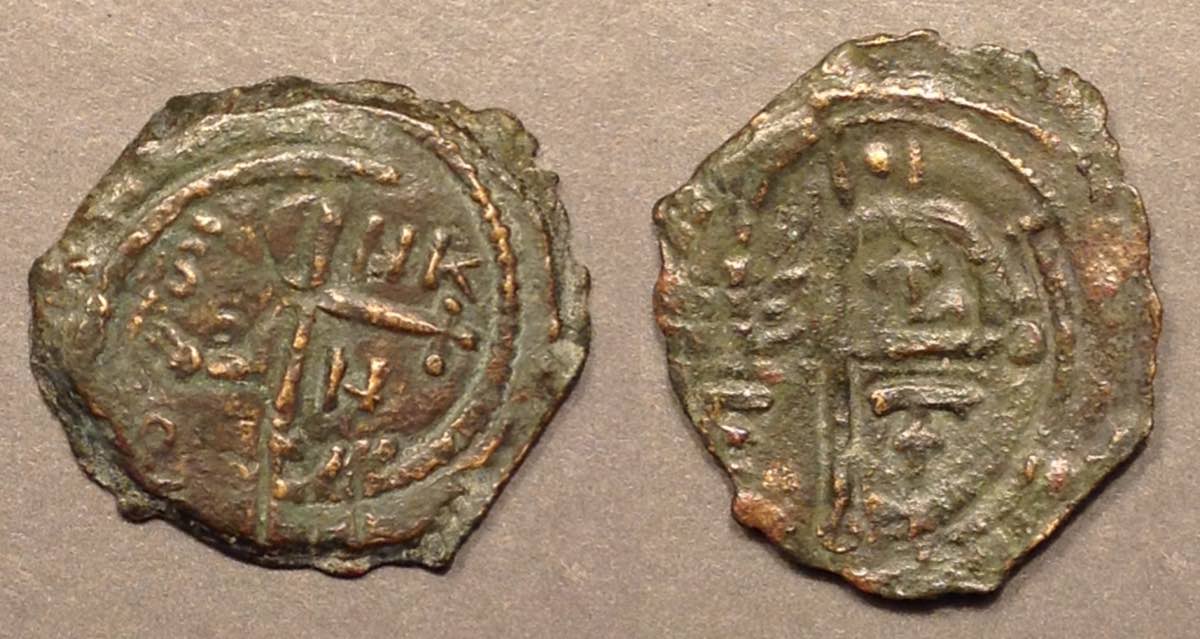
Image 2 of the same coin as Image 1, rotated slightly.
Standing figure, upright and weak, arm out toward 9:00.
9:30 die axis.
There is a bold S with a bar above it at 10:00 in the photo and below it at 7:30 is an O, as on the "St. Peter standing" type (both above and next, for comparison). Just at the top of the vertical of the cross a head can be seen and below it the right arm exending out to the left in blessing as on the "St. Peter standing" type.
In this orientation on the reverse the cross and the lettering below the horizontal are very clear (F and T with an extra crossbar).
Next is the first image again:
 Image 1
Image 1
Bust of Christ upright
9:30 die axis.
The facing bust of Christ with a halo with a single dot in each band is evident. On the reverse, the right half of the reverse is bold including the vertical of the cross, its right side, the
NK
H
in the right quadrants, and the right side of the "floral ornament" at the base of the cross.
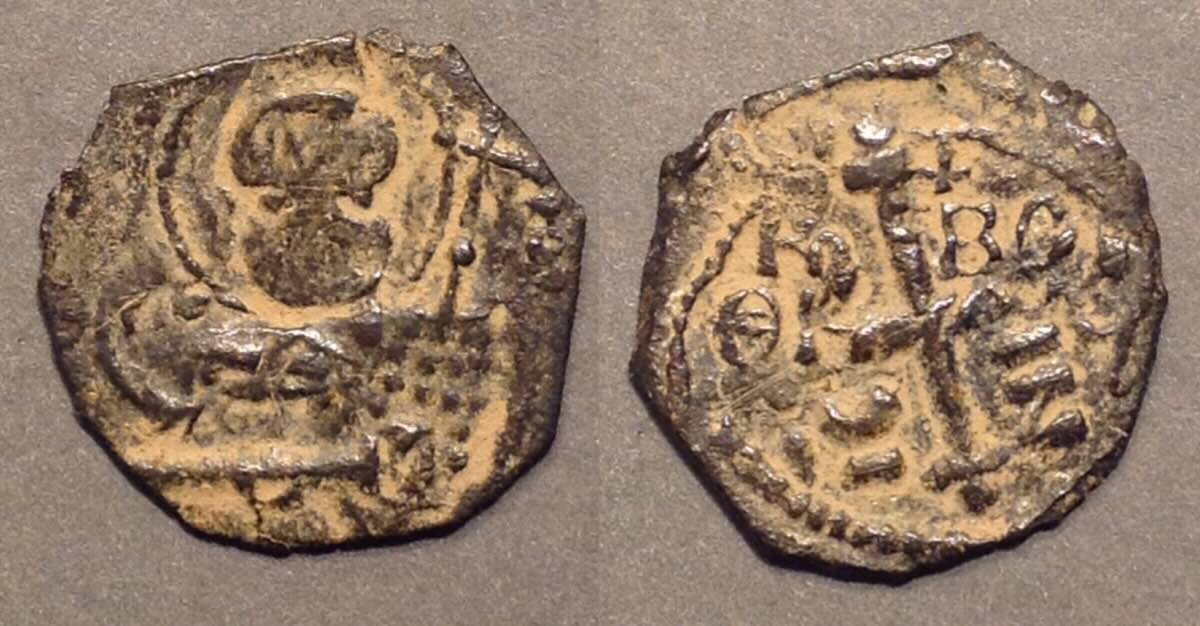 19.8-17.8 mm. 1.92 grams. Thin and light. 6:00 die axis.
19.8-17.8 mm. 1.92 grams. Thin and light. 6:00 die axis.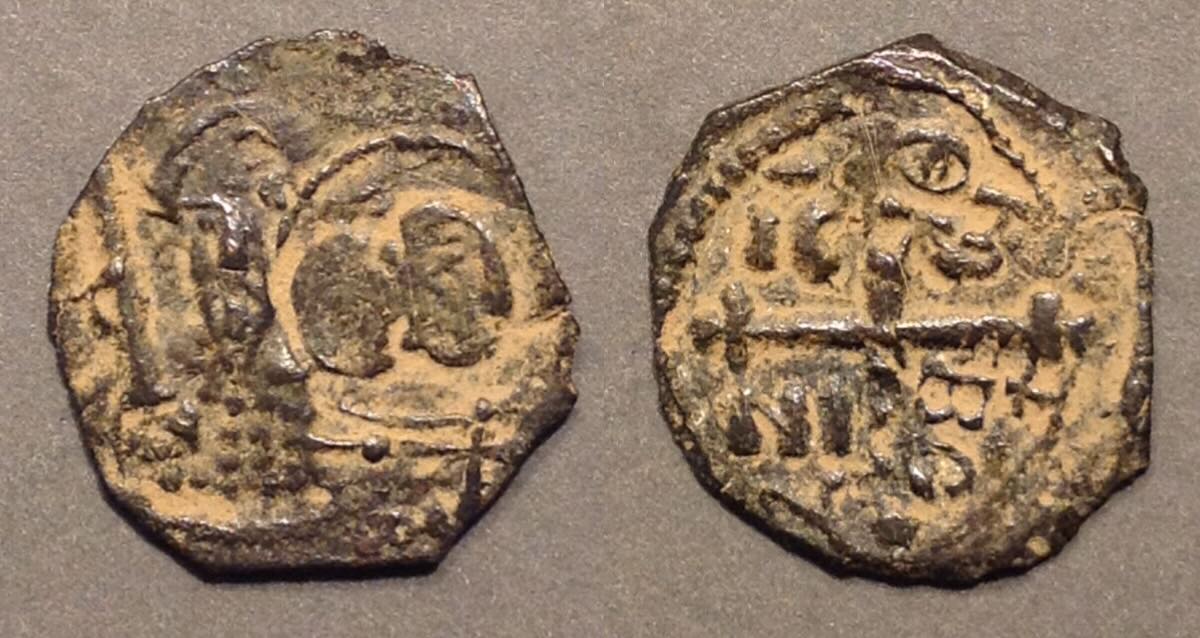 This orientation has his second type, CCS Antioch 4, up.
This orientation has his second type, CCS Antioch 4, up.An overstrike of Roger of Salerno. Roger of Salerno, regent at Antioch, struck three types. Here are two examples.
 St.George riding right, spearing a serpent
St.George riding right, spearing a serpent
Legend
 Mary, orans
Mary, orans
Legend.
 This overstruck coin is oriented with St. George up and Mary toward 9:00.
This overstruck coin is oriented with St. George up and Mary toward 9:00.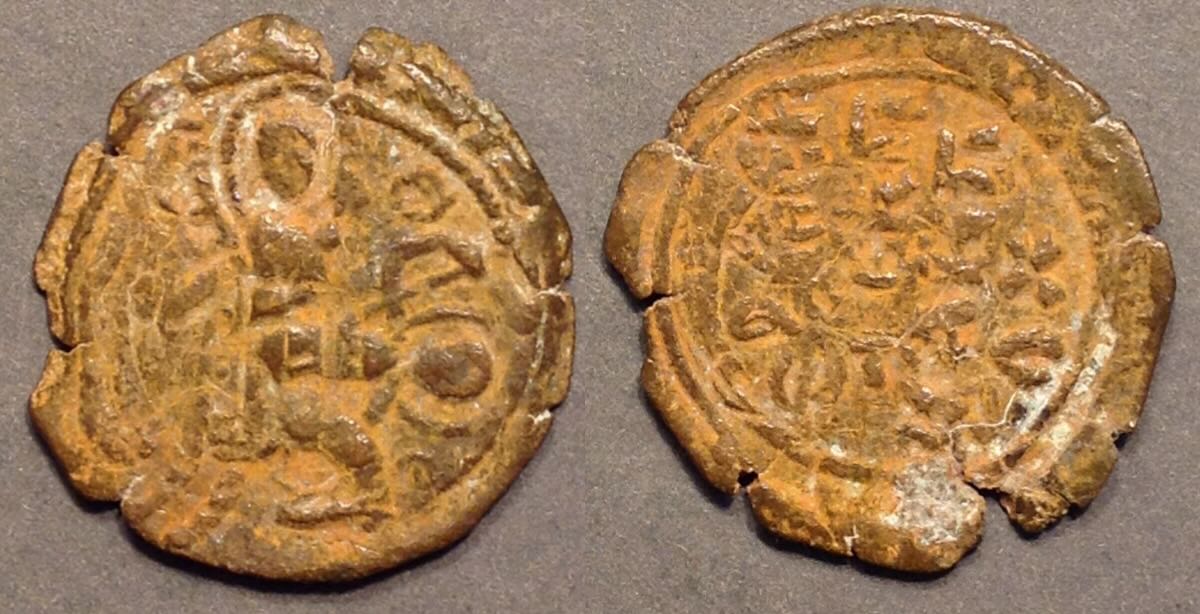 The same coin oriented with Mary up and St. George toward 3:00. The undertype on the reverse is mostly obliterated, but some remains outside the circle at 1:30 (H) and 2:00 (C). The rest of the undertype serves to make the reverse overtype very difficult to read.
The same coin oriented with Mary up and St. George toward 3:00. The undertype on the reverse is mostly obliterated, but some remains outside the circle at 1:30 (H) and 2:00 (C). The rest of the undertype serves to make the reverse overtype very difficult to read.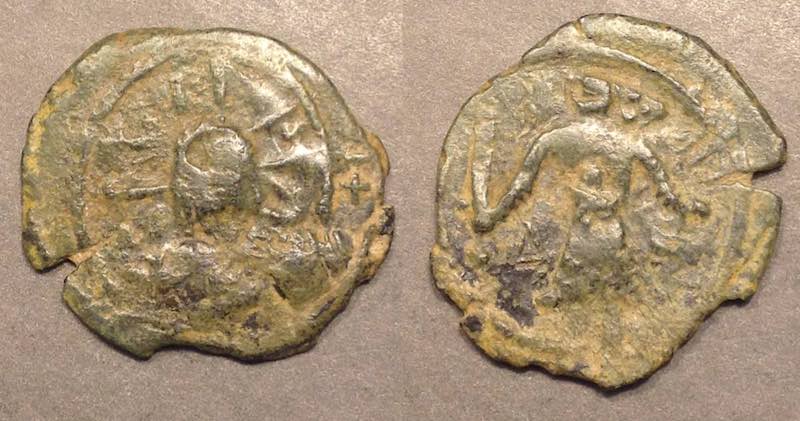 If you closely inspect this green Baldwin II coin (23-21 mm. 3.85 grams, CCS Edessa 12), you can see a small cross at 3:00 on the obverse. If that is from the undertype, imagine that at the top because crosses are often at the top middle (second photo).
If you closely inspect this green Baldwin II coin (23-21 mm. 3.85 grams, CCS Edessa 12), you can see a small cross at 3:00 on the obverse. If that is from the undertype, imagine that at the top because crosses are often at the top middle (second photo).
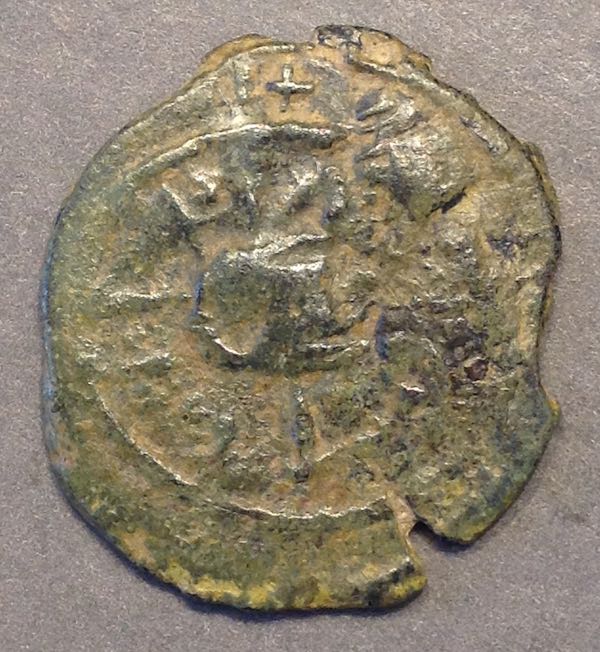 See the cross at the top and the standing figure on the right? It looks a lot like coins with two standing figures, of which we see only the figure on the right. (A full-length standing figure with head at 1:30. )
See the cross at the top and the standing figure on the right? It looks a lot like coins with two standing figures, of which we see only the figure on the right. (A full-length standing figure with head at 1:30. ) 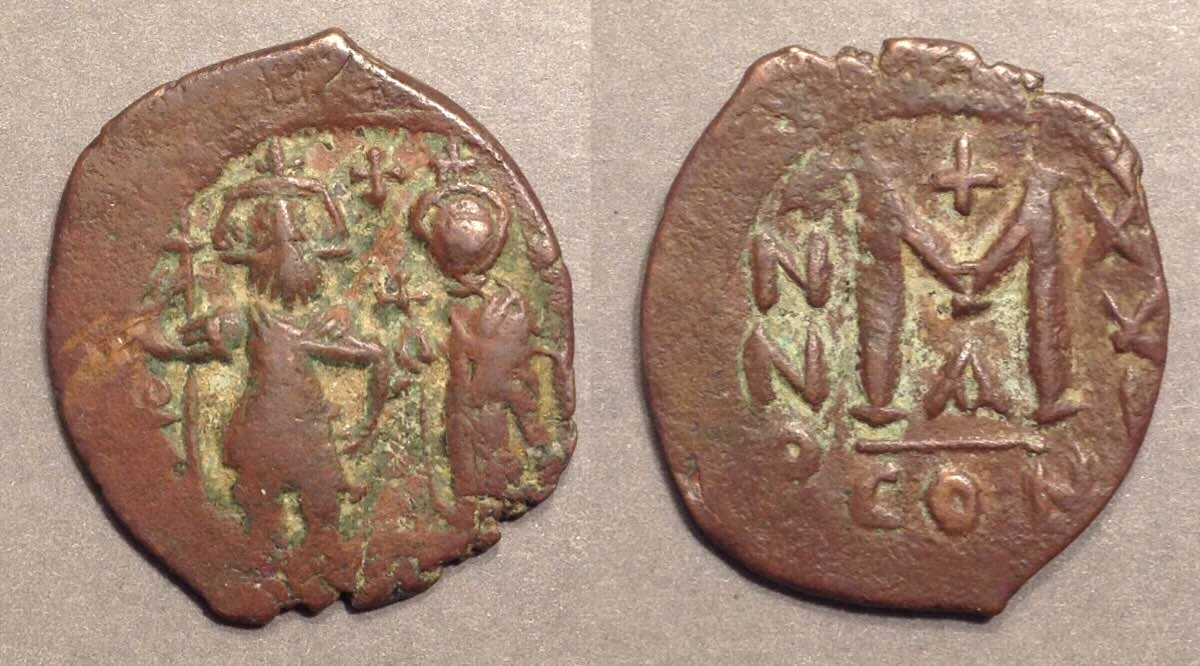 Heraclius and son (610-641), Sear 810.
Heraclius and son (610-641), Sear 810.I do not show the reverse at a new angle because at no angle can I find anything I recognize so I don't know which way to orient up.
So, what is the undertype? I don't know. There are no crusader types with two standing figures. Contemporary Byzantine types are too large to be the undertype. The two-standing-figures type (Sear 1853) of Constantine X (1059-1067) typically weighs 6-10 grams and is 27-30 mm--much too large. Could it be Armenian? After all, Edessa was Armenian when Baldwin I took it over. A close look at Nercessian's book, the standard comprehensive work on Armenian coins, finds no suitable type to be the undertype. Could it be a really old Byzantine coin from centuries earlier? I don't know. Maybe the undertand does not have two standing figures.
(I solicit your thoughts.  )
)